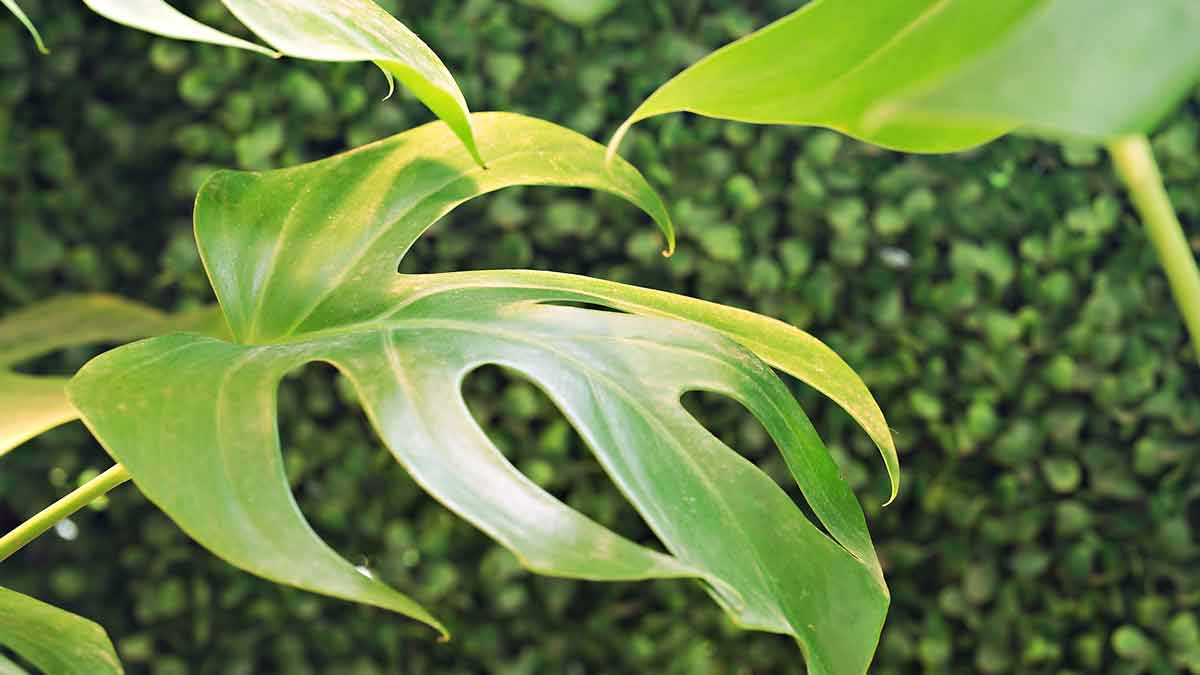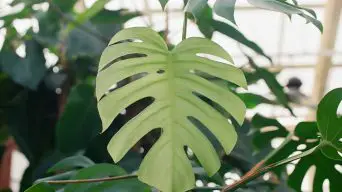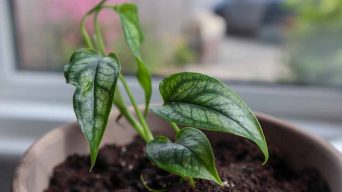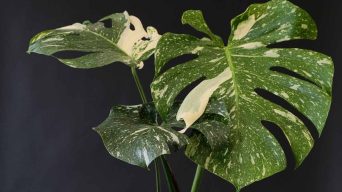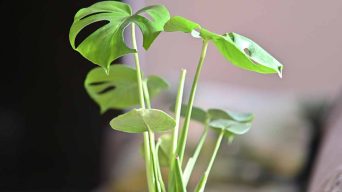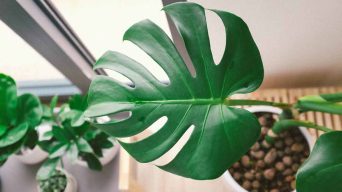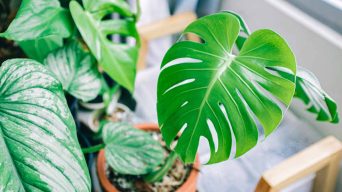Monstera plants can grow indoors or outdoors, but their needs differ. Outdoor plants should be planted in a shady spot with indirect sunlight, while indoor plants need bright indirect light and 65-75°F temps. Monstera plants grow freely outdoors in USDA zones 10 and 12, requiring acclimation and protection elsewhere.
Monstera plants are popular and attractive houseplants known for their lush green foliage with distinctive holes.
They’re relatively easy to care for and can be grown both indoors and outdoors.
Whether you decide to grow your Monstera inside or outside will depend on the climate in your area as well as how much time you have available to devote to its care.
This guide provides an overview of what it takes to grow Monstera plants both indoors and outdoors so that you can choose the best option for your home.
Monstera Plant: A Brief Overview
Monstera plants are a popular choice for indoor houseplants due to their unique and striking appearance.
These plants are known for their large, glossy leaves with distinctive holes and splits, which make them a standout addition to any room.
But can Monstera plants be grown outdoors as well?
Let’s take a closer look at these plants’ natural habitat and growing conditions to answer this question.
Description of the Monstera Plant
The Monstera plant, also known as the Swiss cheese plant or split-leaf philodendron, is a species of flowering plant native to tropical forests of southern Mexico and Panama.
It belongs to the Araceae family and can grow up to 20 meters tall in its natural habitat.
The most distinctive feature of the Monstera plant is its large leaves that can grow up to 90 cm long and 75 cm wide.
The leaves are heart-shaped with deep cuts that give them their characteristic “swiss cheese” appearance.
The holes in the leaves are called fenestrations and are believed to help the plant survive in its natural habitat by allowing light to filter through the dense rainforest canopy.
In addition to its striking appearance, the Monstera plant is also known for its air-purifying properties.
It can remove harmful toxins from the air, making it an excellent choice for indoor environments.
Native Habitat and Growing Conditions
As mentioned earlier, the Monstera plant is native to the tropical forests of southern Mexico and Panama.
In its natural habitat, it grows as an epiphyte or hemiepiphyte on trees or other plants.
To thrive indoors, Monstera plants require bright but indirect light.
Direct sunlight can scorch their leaves and cause them to turn yellow or brown.
They prefer slightly moist soil and generally like to dry out just a bit between waterings.
Overwatering can lead to root rot, so it’s essential not to let them sit in standing water.
Monstera plants also benefit from occasional misting or wiping down their leaves with a damp cloth to increase humidity levels around them.
While they can be grown outdoors in warm climates with high humidity levels, they are primarily grown as indoor houseplants in cooler regions.
Growing Monstera Plants: Indoor and Outdoor Care Guide
When it comes to growing Monstera plants, you have the option of either indoor or outdoor care.
We’ll look at each of these methods in detail so that you can decide which is best for your home.
Indoor Monstera Plant Care
Growing Monstera plants indoors is a great option if you don’t have much outdoor space or live in a cold climate.
However, there are some advantages and disadvantages to consider when deciding whether to keep your Monstera plant inside or outside.
Advantages of Growing Monstera Plant Indoors
One of the biggest advantages of growing Monstera plants indoors is that they can thrive in a variety of lighting conditions.
While they prefer bright indirect light, Monsteras can also tolerate low light levels. This makes them ideal for homes or offices with limited natural light.
Another advantage is that indoor Monstera plants are less susceptible to pests and diseases than outdoor plants.
They are also protected from harsh weather conditions such as wind and frost.
Disadvantages of Growing Monstera Plants Indoors
One disadvantage of growing Monstera plants indoors is that they may not grow as large as outdoor plants. This is because indoor environments typically have lower humidity levels than outdoor environments.
However, this can be mitigated by using a humidifier or placing a tray of water near the plant.
Another disadvantage is that indoor Monstera plants may require more frequent watering than outdoor plants. This is because indoor environments tend to be drier than outdoor environments.
It’s important to keep an eye on the soil moisture levels and adjust your watering schedule accordingly.
Optimal Growing Conditions for Indoor Monstera Plants
To ensure optimal growing conditions for your indoor Monstera plant, there are several factors to consider.
Light
First and foremost is lighting.
Monstera plants require bright but indirect light, so placing them near a window with filtered sunlight is ideal.
Direct sunlight can scorch their leaves, while too little light can stunt their growth or cause Monstera plants to become leggy.
Temperature and Humidity
Monstera plants prefer warm temperatures between 65°F-85°F, with humidity levels around 60%.
If your home is particularly dry or cool, consider using a humidifier or misting the leaves regularly to prevent them from drying out.
Watering
When it comes to watering your indoor Monstera plant, it’s important to strike a balance between overwatering and underwatering.
These plants prefer soil that is evenly moist but not waterlogged, so be sure to check the top few inches of soil regularly with your finger before watering.
If the soil feels dry to the touch, it’s time to water. However, if it feels damp or soggy, hold off on watering until it dries out a bit.
Monstera plants are also sensitive to root rot, so it’s essential not to let them sit in standing water.
Soil and Fertilizer
Monstera plants prefer well-draining soil with a slightly acidic pH. A good potting mix should contain ingredients such as peat moss, perlite, or pumice to help improve drainage.
In addition to soil, Monstera plants benefit from regular feeding during the growing season (spring and summer).
Use a balanced fertilizer every two weeks or so to promote healthy growth and fruit production.
While there are some challenges associated with growing Monstera plants indoors, they can be overcome with proper care and attention.
With bright but indirect light, warm temperatures and humidity levels, proper watering techniques, and regular fertilization, your indoor Monstera plant can thrive and bring a touch of a tropical paradise into your home.
Outdoor Monstera Plant Care
If you’re looking for a larger Monstera plant with lush foliage, growing it outdoors can be an ideal solution.
Advantages of Growing Monstera Plants Outdoors
One major advantage of growing Monstera plants outside is that they tend to grow bigger than their indoor counterparts.
This is because they have access to more space and natural light, which allows them to reach their full potential.
Outdoor Monstera plants are also more resilient to extreme temperatures and humidity levels. They can tolerate warmer climates as well as periods of cold dampness better than indoor plants.
Finally, outdoor Monstera plants require less maintenance than indoor plants, as they don’t need to be watered or fertilized as frequently.
Disadvantages of Growing Monstera Plants Outdoors
On the flip side, one disadvantage of outdoor Monstera plants is that they are much more susceptible to damage from extreme weather conditions such as strong winds, heavy rains, or frost.
It’s important to make sure your Monstera plant is protected from these elements for it to thrive.
Also, outdoor Monstera plants are more susceptible to pests and diseases than indoor ones, which means you’ll need to be vigilant about monitoring them for any signs of trouble.
Optimal Growing Conditions for Outdoor Monstera Plants
If you’ve decided to grow your Monstera plant outdoors, you should keep a few things in mind to ensure its success.
Light
Monstera plants require bright indirect sunlight. Direct sunlight can burn their leaves and cause damage to the plant.
Therefore, placing your Monstera plant in a spot that receives filtered or dappled sunlight is best.
If you live in an area with hot summers, consider placing your plant in a spot that receives morning sun and afternoon shade.
Temperature and Humidity
Monstera plants prefer temperatures between 65°F-85°F (18°C-29°C).
They also require high humidity levels to thrive.
If you live in a dry climate or a region with low humidity, you may want to consider misting your Monstera plant regularly or placing it in a spot where humidity levels are higher (such as near a fountain or other source of water).
Watering
When it comes to watering your outdoor Monstera plant, it is important to keep the soil moist but not waterlogged.
Water your plant thoroughly once a week during the growing season (spring and summer) and reduce watering frequency during the dormant season (fall and winter).
Make sure that your pot has drainage holes to prevent water from accumulating at the bottom of the pot.
You can add some soil amendments to your potting mix to help with drainage.
Soil and Fertilizer
Monstera plants prefer well-draining soil that is rich in organic matter.
You can use a mixture of peat moss, perlite or vermiculite, and compost to create an ideal soil mix for your plant.
Fertilize your outdoor Monstera plant every two weeks during the growing season with a balanced fertilizer.
Make sure to follow the instructions on the packaging and fertilize at half-strength.
It is also important to avoid overfertilizing a Monstera plant, as this can cause foliage burn or root damage.
Monstera Plant: Factors to Consider for Indoor vs. Outdoor Growing
Growing a Monstera plant indoors or outdoors depends on a number of factors.
Before deciding where to place your plant, you should consider the climate and location of your home or garden, the available space, the maintenance and care requirements, and any aesthetic or decorative purposes.
Ultimately, by taking into account all of these factors, you can make an informed decision about whether it’s best to keep your Monstera plant indoors or outdoors.
Climate and Location
The first factor to consider is the climate and location of your area.
Monstera plants are native to tropical regions and thrive in warm and humid environments.
If you live in a region with cold winters or dry summers, it may be best to keep your monstera plant indoors where you can control the temperature and humidity levels.
However, if you live in a warm and humid climate, you may be able to grow your monstera plant outdoors.
Just make sure to choose a shaded location that is protected from direct sunlight, as too much sun can damage the leaves.
Space Availability
Another factor to consider is the space available for your monstera plant.
Indoor plants are typically smaller than outdoor plants, so if you have limited space, an indoor monstera plant may be the better option.
On the other hand, if you have plenty of outdoor space, growing a monstera plant outdoors can add a beautiful touch of greenery to your yard or garden.
Maintenance and Care Requirements
The maintenance and care requirements for indoor and outdoor monstera plants differ slightly.
Indoor plants require regular watering and occasional misting to maintain their humidity levels.
They also need bright but indirect light, so placing them near a window with sheer curtains can provide the ideal lighting conditions.
Outdoor monstera plants require less frequent watering but still need consistent moisture levels in their soil.
They also prefer shady locations with indirect sunlight, so planting them under trees or near walls can provide adequate shade.
Aesthetics and Decorative Purposes
The last factor to consider is the aesthetics and decorative purposes of your monstera plant.
Indoor plants are often smaller and have fewer leaves than their outdoor counterparts, so they can make a great addition to any room in need of some greenery.
Outdoor monstera plants, on the other hand, add a unique touch of beauty and greenery to your garden or yard.
Regardless of where you decide to plant it, a monstera plant can make a great decorative addition to your home.
By taking into account all of these factors, you can decide the best location for your monstera plant, whether indoors or outdoors.
Whichever you choose, with the right care and maintenance, your monstera plant will be a beautiful addition to your home!
Final Thoughts
Monstera plants are versatile and easy-to-care-for houseplants that can bring a unique touch to any home.
Whether you choose to keep your Monstera indoors or outdoors, it is sure to thrive in either location as long as it is given the right environmental conditions.
With proper care, your Monstera will reward you with its gorgeous foliage and air-purifying benefits.
So why not give it a try? You may just fall in love with this magnificent plant!

